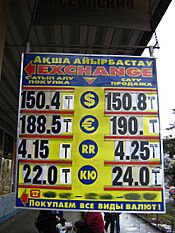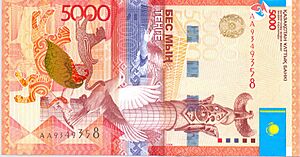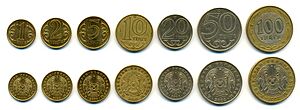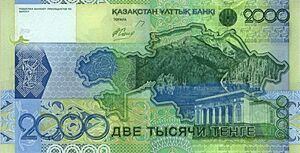Kazakhstani tenge facts for kids
Quick facts for kids Kazakhstani tenge |
|||
|---|---|---|---|
|
|||
| ISO 4217 Code | KZT | ||
| User(s) | |||
| Inflation | 5.0% | ||
| Source | Basic Macroeconomic Indicators on the homepage | ||
| Subunit | |||
| 1⁄100 | tiyn (тиын) | ||
| Symbol | ₸ | ||
| Plural | The language(s) of this currency does not have a morphological plural distinction. | ||
| Coins | |||
| Freq. used | ₸5, ₸10, ₸20, ₸50, ₸100, ₸200 | ||
| Rarely used | ₸1, ₸2 | ||
| Banknotes | |||
| Freq. used | ₸200, ₸500, ₸1,000, ₸2,000, ₸5,000, ₸10,000 | ||
| Printer | Banknote Factory of the National Bank of Kazakhstan | ||
The tenge (pronounced "TENG-gay") is the official money used in Kazakhstan. It's like the dollar in the USA or the euro in Europe. One tenge is made up of 100 smaller units called tiyn (pronounced "tee-IN").
Contents
History of the Tenge
After the Soviet Union broke apart in December 1991, many countries that used to be part of it tried to keep using the same money, the Russian ruble. They hoped to keep strong trade ties.
However, it was hard to keep a single currency when each country was now independent. They needed to agree on money rules and have one main bank to manage everything. This didn't happen easily.
During 1992, 15 independent countries still used the ruble. But each country started printing a lot of money, which caused problems. To protect their own markets, some countries even started using special coupons.
The Russian central bank then set limits on money flowing to other states. The ruble zone finally ended when Russia stopped exchanging old banknotes in July 1993.
Kazakhstan Gets Its Own Money
Because of this, Kazakhstan decided to create its own money. On November 12, 1993, the president of Kazakhstan announced the new national currency. The tenge was officially introduced on November 15, 1993. It replaced the old Soviet money at a rate of 1 tenge for 500 rubles.
A special group of designers – Mendybay Alin, Timur Suleymenov, Asimsaly Duzelkhanov, and Khayrulla Gabzhalilov – created the look of the new tenge. Because of their work, November 15 is now celebrated as the "Day of National Currency of Republic of Kazakhstan."
The first tenge banknotes were printed in the United Kingdom, and the first coins were made in Germany. In 1995, Kazakhstan opened its own factory to print tenge. In 2019, a law was signed to remove all Russian words from new tenge banknotes and coins. This helps show Kazakhstan's unique culture.
What Does "Tenge" Mean?
The word tenge comes from the Kazakh language and other Turkic languages. It means "scales" or "balance," like the kind used to weigh things. This is similar to how other currencies, like the British pound or Italian lira, got their names from units of weight. The Russian word for money, den'gi, also comes from this Turkic word.
The Tenge Symbol
Before 2007, people often just used the letter "T" to show amounts in tenge. In 2006, the National Bank of Kazakhstan held a competition to find a special symbol for their currency. They received over 30,000 ideas!
On March 20, 2007, the National Bank chose a new symbol: ₸. Two designers from Almaty, Vadim Davydenko and Sanzhar Amirkhanov, won the competition. They shared a prize and were called the "parents" of the tenge symbol. This symbol was later added to computer systems in 2009.
Coins of Kazakhstan
Kazakhstan's coins are now made at the Kazakhstan Mint in Oskemen.
First Series (1993)
The first coins came out in 1993. They included small coins called tiyin (2, 5, 10, 20, and 50 tiyin) made of bronze. There were also tenge coins (1, 3, 5, 10, and 20 tenge) made of a different metal. The tiyin coins were stopped in 2001 and were no longer valid money after 2012.
| Image | Denomination | Material | Diameter | Mass | Thickness | Edge | Date of | ||
|---|---|---|---|---|---|---|---|---|---|
| issue | minting | withdrawal | |||||||
 |
2 tiyin | Brass | 17.27 mm | 2.26 g | 1.3 mm | Smooth | 1 March 1994 | 1993 | 31 December 2012 |
 |
5 tiyin | ||||||||
 |
10 tiyin | 19.56 mm | 3.48 g | 1.6 mm | |||||
 |
20 tiyin | 21.87 mm | 4.71 g | 1.7 mm | |||||
 |
50 tiyin | 25 mm | 7.43 g | 2 mm | |||||
 |
T 1 | Nickel silver | 17.27 mm | 2.26 g | 1.3 mm | 25 October 1995 | 1 October 2001 | ||
 |
T 3 | 19.56 mm | 3.48 g | 1.6 mm | |||||
 |
T 5 | 21.87 mm | 4.71 g | 1.7 mm | |||||
 |
T 10 | 25 mm | 7.43 g | 2 mm | |||||
 |
T 20 | 31 mm | 11.37 g | Grooved | |||||
Second Series (1998)
A new set of coins was released in 1998. The ₸1 coin became the smallest value. A ₸100 coin was added in 2002, replacing the ₸100 banknote. A ₸2 coin was introduced in 2005. The metals used for some coins were changed in 2013.
| Second series coins of the Kazakh tenge (1997–2018) | |||||||||||||||
|---|---|---|---|---|---|---|---|---|---|---|---|---|---|---|---|
| Image | Value | Technical parameters | Description | Date of | |||||||||||
| Diameter | Mass | Thickness | Composition | Edge | Obverse | Reverse | minting | issue | withdrawal | lapse | |||||
 |
₸1 | 15 mm | 1.63 g | 1.3 mm | Alloy of "nickel silver", yellow color (since 2013 - carbon steel, galvanic coating yellow metal) |
Plain | Value | Year, Emblem of Kazakhstan | 1997~2018 | 11 November 1998 | Current | ||||
 |
₸2 | 16 mm | 1.84 g | 1.3 mm | 2005,2006 | 23 February 2005 | |||||||||
 |
₸5 | 17.27 mm | 2.18 g | 1.3 mm | 1997~2018 | 11 November 1998 | |||||||||
 |
₸10 | 19.56 mm | 2.81 g | 1.3 mm | |||||||||||
 |
₸20 | 18.27 mm | 2.9 g | 1.6 mm | Alloy of "nickel silver", white color (since 2013 - carbon steel and galvanic nickel) | Grooved | Value | Year, Emblem of Kazakhstan | 1997~2018 | 11 November 1998 | Current | ||||
 |
₸50 | 23 mm | 4.7 g | 1.6 mm | |||||||||||
 |
₸100 | 24.5 mm | 6.65 g | 1.95 mm | Inner disk: alloy of "nickel silver", white color Outer disk: alloy of "nibrass", yellow color. |
Grooved with the note - «СТО ТЕНГЕ - ЖYЗ ТЕҢГЕ» (one hundred tenge) | 2002~2007 | 1 July 2002 | |||||||
| These images are to scale at 2.5 pixels per millimetre. For table standards, see the coin specification table. | |||||||||||||||
Third Series (2019)
In 2019, a new series of coins was released. They have the same sizes and metals as the second series. The big change is that the words on the coins are now in the Latin-based Kazakh alphabet, instead of the Cyrillic alphabet.
This change was part of a plan by former President Nursultan Nazarbayev to switch to a Latin alphabet. It also helps highlight Kazakh culture and reduce Russian influence. The designs were approved in March 2019. Older coins with Cyrillic writing are still valid. In 2020, new ₸200 coins were also released with Latin script.
| Third series coins of the Kazakh tenge (2019–present) | |||||||||||||||
|---|---|---|---|---|---|---|---|---|---|---|---|---|---|---|---|
| Image | Value | Technical parameters | Description | Date of | |||||||||||
| Diameter | Mass | Thickness | Composition | Edge | Obverse | Reverse | minting | issue | withdrawal | lapse | |||||
 |
₸1 | 15 mm | 1.63 g | 1.3 mm | Carbon steel, galvanic coating yellow metal | Plain | Value | Year, Emblem of Kazakhstan | 2019~present | 26 April 2019 | Current | ||||
 |
₸2 | 16 mm | 1.84 g | 1.3 mm | |||||||||||
 |
₸5 | 17.27 mm | 2.18 g | 1.3 mm | |||||||||||
 |
₸10 | 19.56 mm | 2.81 g | 1.3 mm | |||||||||||
 |
₸20 | 18.27 mm | 2.9 g | 1.6 mm | Carbon steel and galvanic nickel | Grooved | Value | Year, Emblem of Kazakhstan | 2019~present | 26 April 2019 | Current | ||||
 |
₸50 | 23 mm | 4.7 g | 1.6 mm | |||||||||||
 |
₸100 | 24.5 mm | 6.65 g | 1.95 mm | Inner disk: alloy of "nickel silver", white color Outer disk: alloy of "nibrass", yellow color. |
Grooved with the note - «JÚZ TEŃGE» (one hundred tenge) | |||||||||
  |
₸200 | 26 mm | 7.5 g | 1.9 mm | Aluminium-brass center in copper-nickel ring | Sixteen indentations ('Spanish flower') with alternate plain and reeded sections | 2020~present | 28 January 2020 | |||||||
| These images are to scale at 2.5 pixels per millimetre. For table standards, see the coin specification table. | |||||||||||||||
Special Commemorative Coins
Kazakhstan also makes special Commemorative coins to celebrate important events. These come in different values, from ₸20 to ₸10,000. Some are made of silver and gold. Many of the ₸20 and ₸50 commemorative coins are also made from a copper-nickel mix and sometimes end up in everyday circulation.

Banknotes of Kazakhstan
1993 Series Banknotes
On November 15, 1993, the National Bank of Kazakhstan released the first banknotes. These included tiyn notes (1, 2, 5, 10, 20, 50 tiyn) and tenge notes (1, 3, 5, 10, 20, 50, and 100 tenge). Later, in 1994, ₸200, ₸500, and ₸1,000 notes were added. Higher values like ₸2,000 (1996), ₸5,000 (1999), and ₸10,000 (2003) followed.
Some of the notes from this series that were in use for a long time featured:
- ₸200 - a picture of Al-Farabi, a famous scholar.
- ₸500 - Al-Farabi and a part of the Khodzha Akhmet Yassaui mausoleum.
- ₸1,000 - Al-Farabi.
- ₸2,000 - Al-Farabi.
- ₸5,000 - Al-Farabi.
- ₸10,000 - Al-Farabi and a snow leopard.
| 1993 Series | ||||||||
|---|---|---|---|---|---|---|---|---|
| Image | Value | Main Colour | Description | Date | ||||
| Obverse | Reverse | Obverse | Reverse | Obverse | Reverse | issue | annul | |
 |
 |
1 tiyn | green | green | value in numeral and Kazakh, unique geometric design background | value in numeral and Kazakh, Kazakhstan coat of arms, unique geometric design background | 1993 | 2001 |
 |
 |
2 tiyn | light blue | light blue | ||||
 |
 |
5 tiyn | pink | pink | ||||
 |
 |
10 tiyn | red | red | ||||
 |
 |
20 tiyn | blue, grey | blue | ||||
 |
 |
50 tiyn | brown, yellow | brown | ||||
 |
 |
T 1 | blue | light blue | Portrait of Al-Farabi | Geometrical constructions and formulations of Al-Farabi | 2012–2018 | |
 |
 |
T 3 | green | bluish green | Portrait of Suinbai Aronuly | Alatau landscape | ||
 |
 |
T 5 | brown | yellow, orange | Portrait of Kurmangazy | Kurmangazy mausoleum | ||
| T 10 | green | light green | Portrait of Chokan Ualihanov | Ok Zhetpes mountain | ||||
| T 20 | brown | light brown | Portrait of Abay Kunanbaev | Illustration of golden eagle with the man, drawn from works of Abay Kunanbaev | ||||
| T 50 | reddish | light red | Portrait of Abulhair Khan | Rock paintings of Mangistau | ||||
| T 100 | violet | pink | Portrait of Ablay Khan | Hodja Ahmed Yassavi mausoleum | ||||
| T 200 | brown, red | yellow, blue | Portrait of Al-Farabi | 1994 | ||||
| T 500 | dark blue, blue | blue, violet | ||||||
| T 1,000 | green, red | green, blue, red | ||||||
| T 2,000 | green, blue | green, brown | 1996 | |||||
 |
 |
T 5,000 | brown, violet | brown | 1998 | |||
 |
 |
T 10,000 | blue | blue, brown | Snow leopard against a background of mountains | 2003 | ||
2006 Series Banknotes
The National Bank of Kazakhstan released a new series of banknotes in 2006. These new notes replaced the older ones with the same value.
The 2006 series looks quite unique. The front of each note is vertical. It shows the Bayterek monument, the Kazakh flag, the country's coat of arms, and a handprint with the signature of former President Nursultan Nazarbayev. It also has parts of the national anthem. The main differences between these notes are their colors and values.
The back of each note is horizontal and more varied. It shows a unique building and a map of Kazakhstan's geography. The value is written in Russian on the back.
Interestingly, some of the first ₸2,000 and ₸5,000 notes from 2006 had a spelling mistake for the word "bank" in Kazakh. This was a big deal because the Kazakh language is very important to the country's culture.
On October 3, 2016, the ₸2,000, ₸5,000, and ₸10,000 banknotes from this series were no longer valid for everyday use. People had a year to exchange them at banks.
| 2006 Series | ||||||
|---|---|---|---|---|---|---|
| Image | Value | Main Colour | Description | Date of issue | ||
| Obverse | Reverse | Obverse | Reverse | |||
 |
 |
₸200 | orange | Astana Bayterek monument, Kazakhstan flag, Kazakhstan coat of arms, handprint with a signature of Kazakh President Nursultan Nazarbayev, fragments of the national anthem, value in numerals and Kazakh words, issuing bank in Kazakh, inscription in Kazakh stating that counterfeiting banknotes is against the law | Transport and Communication Ministry and a winged snow leopard on the bridge over River Ishim, outline map of Kazakhstan with Ministry of Defense and the steppes in the background, value in Russian, name of issuing in Kazakh, logo of issuing bank, inscription in Russian stating that counterfeiting banknotes is against the law | 2006–2016 |
 |
 |
₸500 | blue | Ministry of Finance and Akimat (City Hall) of Astana, outline map of Kazakhstan with gulls over the sea in background, value in Russian, name of issuing in Kazakh, logo of issuing bank, inscription in Russian stating that counterfeiting banknotes is against the law | ||
 |
 |
₸1,000 | brown | President Culture Center, outline map of Kazakhstan with mountains in background, value in Russian, name of issuing in Kazakh, logo of issuing bank, inscription in Russian stating that counterfeiting banknotes is against the law | ||
 |
 |
₸2,000 | green | Abai Opera House, outline map of Kazakhstan with mountain lake in background, value in Russian, name of issuing in Kazakh, logo of issuing bank, inscription in Russian stating that counterfeiting banknotes is against the law | ||
 |
 |
₸5,000 | red | Independence Monument and the Kazakhstan Hotel, outline map of Kazakhstan with mountains in background, value in Russian, name of issuing in Kazakh, logo of issuing bank, inscription in Russian stating that counterfeiting banknotes is against the law | ||
 |
 |
₸10,000 | purple | Residence Akorda (presidential palace), outline map of Kazakhstan with canyons in the background, value in Russian, name of issuing in Kazakh, logo of issuing bank, inscription in Russian stating that counterfeiting banknotes is against the law | ||
2011–2017 Series Banknotes
The National Bank of Kazakhstan released another new series of banknotes between 2011 and 2017. These notes came in values of ₸1,000, ₸2,000, ₸5,000, and ₸10,000. The front of these notes features the "Kazakh Eli" monument, which represents Kazakhstan's independence.
On December 1, 2015, a new ₸20,000 banknote was introduced. It was a special commemorative note to celebrate 20 years of Kazakhstan's national currency. In 2017, a ₸500 banknote was added to this series.
| 2011–2017 Series | ||||||
|---|---|---|---|---|---|---|
| Image | Value | Main Color | Description | Date of issue | ||
| Obverse | Reverse | Obverse | Reverse | |||
| [1] | [2] | ₸500 | Blue | Flag, skyscrapers, "Kazakh Eli" monument in Astana (representing the "Independence of Kazakhstan" and the "Continuation of Generations"), Emblem of Kazakhstan and Flag of Kazakhstan | Outline of Kazakhstan, seagulls | 2017 |
| [3] | [4] | ₸1,000 | Yellow, brown, orange and blue | "Kazakh Eli" monument in Astana (representing the "independence of Kazakhstan" and the "Continuation of Generations"), pigeons, Emblem of Kazakhstan and Flag of Kazakhstan | Outline of Kazakhstan, mountains and landscape of the Ustyurt Plateau | 2014 |
| [5] | [6] | ₸2,000 | Green | "Kazakh Eli" monument in Astana (representing the "independence of Kazakhstan" and the "Continuation of Generations"), Khan Shatyr tent, pigeons, Emblem of Kazakhstan and Flag of Kazakhstan | Outline of Kazakhstan, Ertis/Irtysh river | 2012 |
| [7] | [8] | ₸5,000 | Red, blue, yellow, and green | "Kazakh Eli" monument in Astana (representing the "independence of Kazakhstan" and the "Continuation of Generations"), Palace of Independence, pigeons, Emblem of Kazakhstan and Flag of Kazakhstan | Outline of Kazakhstan, Monument of Independence, Hotel "Kazakhstan" (Almaty/Alma Ata), Zailijsky Alatau ridge of Tjan-Shan mountain range | 2011 |
| [9] | [10] | ₸10,000 | Violet and blue | Outline of Kazakhstan, Residence Ak Orda (Palace of the President), Astana | 2012 | |
| [11] | [12] | ₸20,000 | Blue-gray and violet | "Kazakh Eli" monument in Astana (representing the "independence of Kazakhstan" and the "Continuation of Generations"), pigeons, Emblem of Kazakhstan, Flag of Kazakhstan and the Mangilik El triumphal arch | Outline of Kazakhstan, Residence Ak Orda (Palace of the President) and Government buildings in Astana, arranged in order by the principle of separation of powers, as written in the Constitution of the Republic of Kazakhstan | 2015 |
2023-2025 Series Banknotes
The National Bank of Kazakhstan started releasing a new series of banknotes called "Saka" from 2023. These notes are smaller, no longer have Russian text, and include new security features. Older banknotes will gradually be replaced, but you can still exchange them at banks for a few years.
Special Commemorative Banknotes
Since 2008, Kazakhstan has issued many special banknotes to celebrate important events. These include notes for the 2011 Asian Winter Games. These special notes are usually for ₸1,000, ₸2,000, ₸5,000, and ₸10,000.
Digital Tenge
The National Bank of Kazakhstan has also announced plans to create a digital version of its currency. This would be like a digital form of cash.
Exchange Rates and Inflation
Money values can change over time. This is called the exchange rate.
- On September 2, 2013, the tenge was linked to the US dollar and the Russian ruble.
- On February 11, 2014, the tenge's value dropped by 19% against the US dollar. This happened because the Russian ruble was getting weaker.
- On August 20, 2015, Kazakhstan's National Bank decided to let the tenge's value float freely. This means its value is now decided by how much people want to buy or sell it in the market. Because of this change, the tenge lost 30% of its value in just one day.
Inflation is when prices for things go up over time, meaning your money buys less. Kazakhstan has seen its inflation rate change a lot over the years. For example, in 1994, inflation was very high, but it has generally been much lower in recent years.






